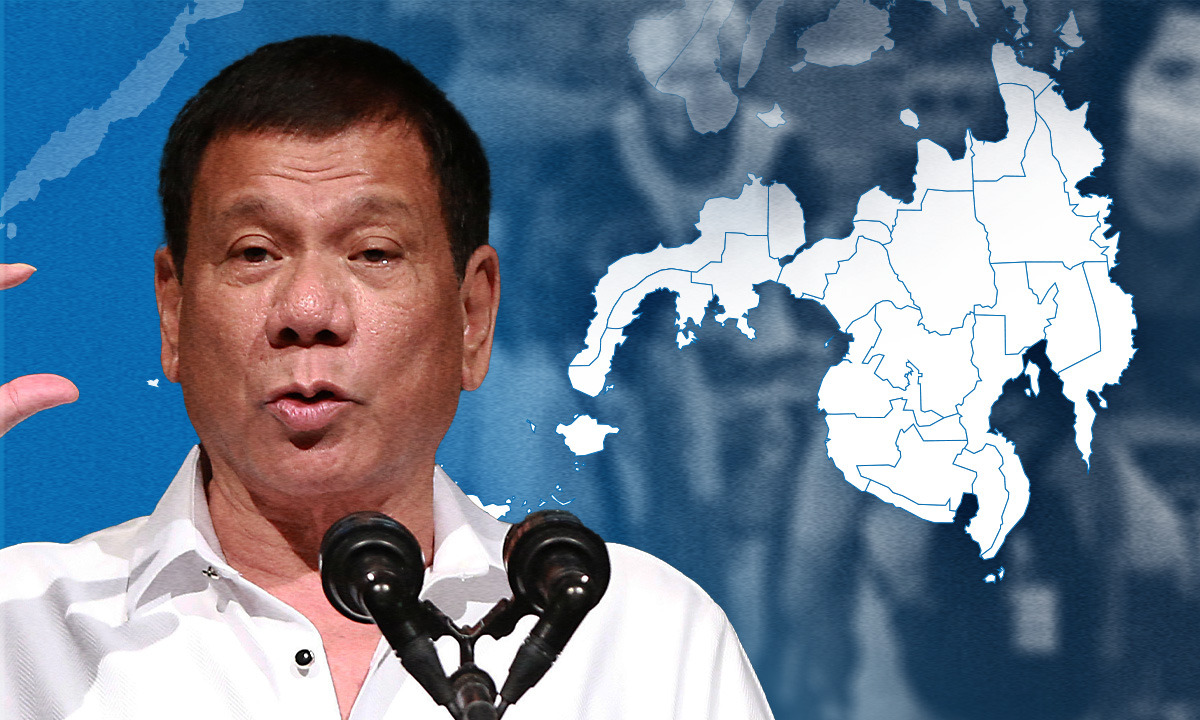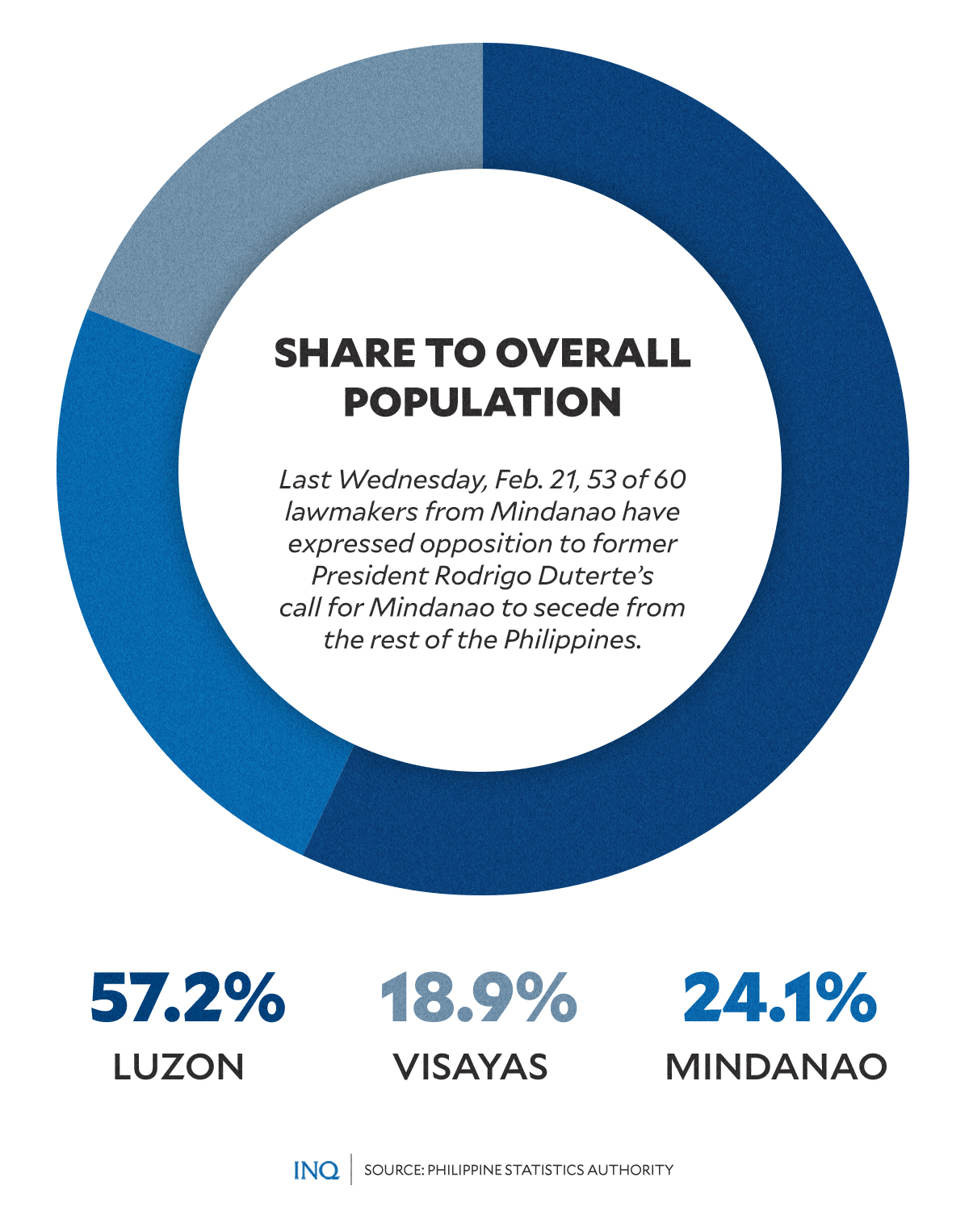Serious or bluster, Duterte’s call for Mindanao state raises tough questions
MANILA, Philippines—Retired Associate Supreme Court Justice Antonio Carpio described it as “hot air” but questions hound the recent rant of ex-President Rodrigo Duterte about Mindanao being neglected and calling for a separate state.
No one can say with certainty if the former ruler was serious about calling for Mindanao to secede except Duterte himself, who had been known for his penchant for expletives and bluster in his six years as president.
But one thing is certain, according to Maria Ela Atienza, political science professor at the University of the Philippines Diliman. Duterte’s call for secession, she said, “hijacks genuine attempts towards peace and development in Mindanao.”
Atienza said that Duterte’s words could likewise cause divisions again not only in Mindanao but the entire country especially on peace and nation-building and the identity of the Filipino.
‘Separate Mindanao’
Last month, Duterte, the first president from Mindanao, proposed the secession of the island from the rest of the Philippines, but adding that what he wanted was “not a rebellion.”
“What is at stake now is our future, so we’ll just separate,” Duterte said as he listed reasons he was calling for secession.
Duterte made the call amid attempts to change the Constitution through people’s initiative which the former ruler opposed, accusing his successor, President Ferdinand “Bongbong” Marcos Jr. of simply wanting to keep himself in power like his father, the late president Ferdinand Marcos Sr., who ruled for more than 20 years after a successful amendment of the 1935 Constitution.
READ: ‘It’s the fentanyl,’ Marcos says after former president Duterte tags him ‘drug addict’
According to Duterte, the Philippines, especially Mindanao, has not attained progress over a succession of presidents, which included him.
Marcos Jr. had allied with Duterte’s daughter, Sara, to win the 2022 elections.
A Duterte ally, Rep. Pantaleon Alvarez (Davao del Norte) had told ANC “we are always last in the priority and, if not last, we are forgotten.” Alvarez had been Speaker but was ousted in a House leadership coup believed to have been orchestrated by Sara Duterte, now vice president.
RELATED STORY: Mindanao in ‘toxic relationship’ with ‘sinking’ PH; must secede – Rep Alvarez
“We have to find a way where the concerns of the people would be addressed by the government,” said Alvarez, who had been identified by the former president as the one in charge of collecting signatures for Mindanao separation.
According to data from the Philippine Statistics Authority (PSA), Mindanao is home to over 26 million people, making it the second most populous island, next to Luzon, which has a population of a little over 62 million.
Mindanao’s share of the national population is 24.1 percent.
‘On our own’
According to Duterte, a Mindanao that is separate from the Philippines can stand on its own. “We have everything and yet we give all our resources (to Luzon and the Visayas,” he said.
Still according to PSA data, all the economies of the 17 regions of the Philippines had positive growth in 2022, with Davao Region having the one of “fastest” at 8.15 percent.
However, regions in Mindanao have the highest poverty incidence, too: Zamboanga Peninsula (23.4 percent), Northern Mindanao (19.2 percent), Davao Region (11.9 percent), Soccsksargen (21.4 percent), Caraga Region (25.9 percent), and BARMM (29.8 percent).
PSA data showed that government spending in all regions of the Philippines had positive growth, with Northern Mindanao having the highest in the island at 3.9 percent, 1 percent lower than the 4.9 percent national average.
But in a manifesto, 57 lawmakers, 53 from Mindanao, opposed Duterte’s call, saying that it was a stand for “national unity” and belief in “inclusive development.”
READ: 57 House reps sign manifesto vs. ex-President Duterte’s Mindanao republic idea
They said that the challenges facing Mindanao and the rest of the Philippines “demand collective action and shared responsibility,” stressing that Mindanaoan’s aspirations can be realized more effectively through a “unified and sovereign Philippines.”
It was pointed out by Atienza that peace negotiations and the creation of an autonomous region, especially in the years when Duterte was president, were attempts not only to develop and pay attention to Mindanao.
RELATED STORY: National unity over independent Mindanao, says former regional official
“It was part of the continuing nation-building process in a multicultural country such as the Philippines.”
Assessing strength
Atienza told INQUIRER.net that Filipinos should especially take into consideration that when Duterte and Alvarez issued the call for Mindanao’s independence, there was a heated exchange between the clashing political clans—the Dutertes and the Marcoses.
“Duterte has a tendency to exaggerate as we are aware of, but he may also be testing how strong he still is, particularly in Mindanao, as well as testing how Marcos and his administration will react,” she said.
She stressed, however, that Duterte’s call is contrary to what he had advocated for when he was campaigning for the presidency and when he was already in Malacañang. “He emphasized then the need for peace and development in Mindanao.”
Atienza explained that in the first half of his stint as president, Duterte had premised his campaign for federalism on bringing lasting peace and development in Mindanao as part of the Philippines, pointing to what Duterte said in 2016.
Back in the first months of his presidency, Duterte had said: “Let me remind you again. Per my observation, we cannot have a peaceful country […] if you do not agree to a federal setup.”
READ: Only federalism will bring lasting peace, says Duterte
For Atienza, Duterte’s declaration also goes against the operation of the BARMM, or the Bangsamoro Autonomous Region in Muslim Mindanao, which was a result of the peace negotiations and one of the “centerpieces or achievements of his administration.”
She stressed that BARMM is still a continuing effort on autonomy and peace, and elections are already getting close: “It should be allowed to operate and evolve, like ARMM, to see how best to maintain and build genuine autonomy, peace and development.”
Almost impossible
For Marcos, “the new call for a separate Mindanao is doomed to fail,” pointing out the “this grave violation of the Constitution” has already been “repudiated” by the present leadership of BARMM.
As explained by Duterte, “there is a process in the UN (United Nations) where you would gather signatures in Mindanao verifying under oath, in the presence of the many people, that you want a separate (nation).”
However, lawyer Domingo Cayosa, former president of the Integrated Bar of the Philippines, stressed that the protection of territorial integrity is clearly stated in the Constitution, making Duterte’s dream of an independent Mindanao “practically impossible.”
“Even if theoretically, this signature campaign that they are talking about, even if they would have all Mindanaoans sign, let’s say that’s a legitimate People’s Initiative’, you still need the cooperation of all the provinces and districts of the Philippines,” he told Teleradyo Serbisyo.
Section 2, Article XVII of the 1987 Constitution provides that amendments may be proposed by the people through initiative. A petition has to be supported by at least 12 percent of all registered voters, with at least three percent from every legislative district.
However, based on latest decisions by the Supreme Court, only minor changes are allowed through People’s Initiative, not substantial revisions such as a change of form of government. He said, though, that Duterte’s call was not illegal.
As for the UN, it was stated in the article, “To Secede or Not Secede? Is It Even Possible?” by Cook (2019) and published by the Indiana Journal of Global Legal Studies that there is “no explicit rule affirming or denying a right to secede.”
Self-serving call?
But whether there is basis for Duterte’s call, equally significant to take into consideration was the context of why he has all of a sudden asked for Mindanao to be separated from the Philippines.
Remember that Duterte, ahead of making the call, had warned in a YouTube interview that “repugnant” attempts to change the Constitution could lead to a new one that might “destroy the nation.”
For Rep. Raoul Manuel (Kabataan), the former president’s declaration might be only to divert attention away from possible prosecution by the International Criminal Court for the killings allegedly committed in his war on drugs.
“In fact, the Dutertes just want to turn Mindanao into an escape bunker at a time when they are being hunted by the ICC when the investigation progresses and they are convicted of their crimes against the Filipino people,” he said.
But while Cayosa had pointed out that Duterte’s call is not illegal and only an “exercise of his democratic right to express his sentiments,” the government stressed that it was ready to use “resolute force” against attempts to divide the nation.
As pointed out by National Security Adviser Eduardo Año, “the national government will not hesitate to use its authority and forces to quell and stop any and all attempts to dismember the Republic.”



